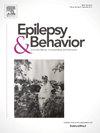颞叶中叶硬化症相关耐药颞叶癫痫患者术前视频脑电图、发作期SPECT和MRI之间的侧位一致性与皮质-杏仁核-海马切除术后积极的精神治疗结果相关吗?一项回顾性队列研究
IF 2.3
3区 医学
Q2 BEHAVIORAL SCIENCES
引用次数: 0
摘要
目的与颞中叶硬化症(MTS)相关的耐药性颞叶癫痫(TLE)患者合并精神障碍(PD)的发生可被视为生物和社会心理因素以及抗癫痫药物(ASM)影响之间复杂相互作用的结果。在生物学方面,尽管相关知识日益丰富,但仍缺乏文献数据说明更精确地定义发作起始区(SOZ)是否与更有利的术后精神治疗结果相关。本研究评估了药物抵抗性 TLE-MTS 患者手术前的临床和社会人口学变量,包括神经电生理和神经影像学检查结果,旨在研究皮质-丘脑-大脑皮质切除术(CAH)后出现 PD 的可能风险因素。方法 对最初106名伴有PD(n = 51; 48.1 %)和不伴有PD(n = 55; 51.9 %)的药物耐药性TLE-MTS患者手术前的病历进行回顾性队列分析。对两组患者手术前的临床和社会人口学数据进行了比较,并对手术后出现 PD 的预测因素进行了分析,直至 CAH 术后一年和两年。结果17 名患者(16%)在术后第一年失去了随访,89 名患者(84%)完成了研究。两组患者在临床和社会人口学方面均未发现差异(p > 0.05),但曾接受过精神病治疗的患者除外(p = 0.001)。18名(35.29%)术前有帕金森氏症病史的患者在 CAH 后帕金森氏症得到缓解,而 8 名(14.5%)患者出现了新的帕金森氏症。既往的肢端麻痹症病史与 CAH 一年后手术后肢端麻痹症的发生直接相关(p < 0.0001)。既往精神病治疗史(p <0.01)、既往情绪病史(p = 0.002)和焦虑症病史(p = 0.03)以及 MRI、SPECT 和 EEG 的侧位不一致(p = 0.02)是 CAH 两年后发生帕金森病的预测因素。结论:本研究观察到,耐药 TLE-MTS 患者术前检查结果的侧位一致性与术后精神状况良好之间存在关联。这些结果表明,更精确地定义SOZ可能与CAH术后更有利的精神治疗结果有关。本文章由计算机程序翻译,如有差异,请以英文原文为准。
Is lateralization concordance between preoperative video-EEG, ictal SPECT, and MRI to be associated with positive psychiatric outcomes after cortico-amygdalohippocampectomy in patients with pharmacoresistant temporal lobe epilepsy associated to mesial temporal sclerosis? A retrospective cohort study
Objective
The occurrence of comorbid psychiatric disorders (PD) in patients with pharmacoresistant temporal lobe epilepsy (TLE) associated to mesial temporal sclerosis (MTS) can be considered as a result of the complex interaction between biological and psychosocial factors, as well as the effects of antiseizure medications (ASM). Regarding biological aspects, despite the growing amount of knowledge, there is still a scarcity of data in literature clarifying whether a more precise definition of the seizure onset zone (SOZ) could be associated with a more favorable post-surgical psychiatric outcome. In the present study, the clinical and sociodemographic pre-surgical variables, including the results of neurophysiological and neuroimaging exams, were evaluated in patients with pharmacoresistant TLE-MTS aiming to investigate possible risk factors for the presence of PD after cortico-amygdalohippocampectomy (CAH).
Methods
A retrospective cohort analysis of medical records from initially 106 pre-surgical patients with pharmacoresistant TLE-MTS with PD (n = 51; 48.1 %) and without PD (n = 55; 51.9 %) proceeded. Pre-surgical clinical and sociodemographic data were compared between both groups and the predictors for the presence of post-surgical PD were characterized up to one and two years after CAH.
Results
Seventeen patients (16 %) had lost their follow-up in the first year after surgery, and 89 (84 %) had completed the study. No clinical and sociodemographic differences were observed between both groups of patients (p > 0.05), except for a history of previous psychiatric treatment (p = 0.001). Eighteen patients (35.29 %) with pre-surgical history of PD had remission of PD after CAH, while eight (14.5 %) developed de novo PD. The previous history of PD was directly associated with the development of post-surgical PD one year after CAH (p < 0.0001). Previous psychiatric treatment (p < 0.01), previous history of mood (p = 0.002) and anxiety (p = 0.03) disorder, as well as discordance in lateralization between MRI, SPECT, and EEG (p = 0.02), were predictors for the development of PD two years after CAH. Post-surgical psychiatric outcomes were associated to seizure outcome based on the Engel classification (p < 0,0001).
Conclusion
The present data observed an association between lateralization concordance of results of pre-surgical investigative exams and positive postoperative psychiatric outcomes in patients with pharmacoresistant TLE-MTS. These results could suggest that a more precise definition of the SOZ could be associated with a more favorable post-surgical psychiatric outcome after CAH.
求助全文
通过发布文献求助,成功后即可免费获取论文全文。
去求助
来源期刊

Epilepsy & Behavior
医学-行为科学
CiteScore
5.40
自引率
15.40%
发文量
385
审稿时长
43 days
期刊介绍:
Epilepsy & Behavior is the fastest-growing international journal uniquely devoted to the rapid dissemination of the most current information available on the behavioral aspects of seizures and epilepsy.
Epilepsy & Behavior presents original peer-reviewed articles based on laboratory and clinical research. Topics are drawn from a variety of fields, including clinical neurology, neurosurgery, neuropsychiatry, neuropsychology, neurophysiology, neuropharmacology, and neuroimaging.
From September 2012 Epilepsy & Behavior stopped accepting Case Reports for publication in the journal. From this date authors who submit to Epilepsy & Behavior will be offered a transfer or asked to resubmit their Case Reports to its new sister journal, Epilepsy & Behavior Case Reports.
 求助内容:
求助内容: 应助结果提醒方式:
应助结果提醒方式:


